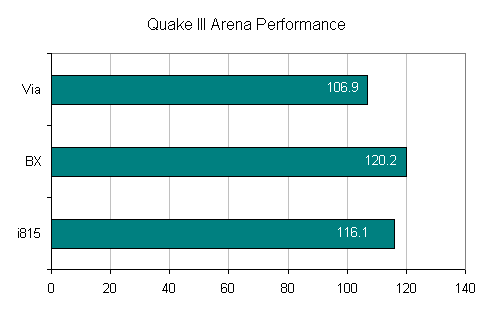Linux Pentium III Chipset Comparison
by Jeff Brubaker on December 18, 2000 12:00 PM EST- Posted in
- CPUs
3D AGP Performance: Gears and Quake
GearsWe will start the AGP benchmarks with Gears. Gears is less of a benchmark and more of a dirt simple OpenGL application. That's what makes it great for benchmarking; it's requires no texturing and very few triangles per frame. The result is that it is almost a purely AGP bandwidth limited test. The XFree86 programmers routinely use gears as a means of testing driver efficiency.

Unfortunately, this benchmark did not yield any interesting results. All platforms scored equally well. This is particularly interesting because each supports different levels of AGP compliance and the BX is running at a higher clock than the other two. There must be another factor limiting performance in this case.
Quake 3 ArenaQuake 3 Arena may provide a good real world benchmark of performance, but we're interested in stressing the bus, not the video card. So, the solution is to render at 640x480, thus reducing the amount of fill rate weight on the performance of the application. Yes, this does not provide the realistic usage viewpoint, but increasing resolution does nothing other than make the scores closer and closer. Note that in addition to being limited by the AGP bus, Quake 3 Arena stresses memory bandwidth considerably.

Here, the 89MHz AGP bus on the BX chipset appears to have given the BX a lead over the other two. The 815 beats the VIA by a relatively minor 9% that could be due to AGP 4X vs. AGP 2X differences or a general minor design advantage. The other factor in play here is memory bandwidth. As we will see later, the BX chipset has a very efficient memory controller, which also helps it beat out the VIA in this comparison.










0 Comments
View All Comments